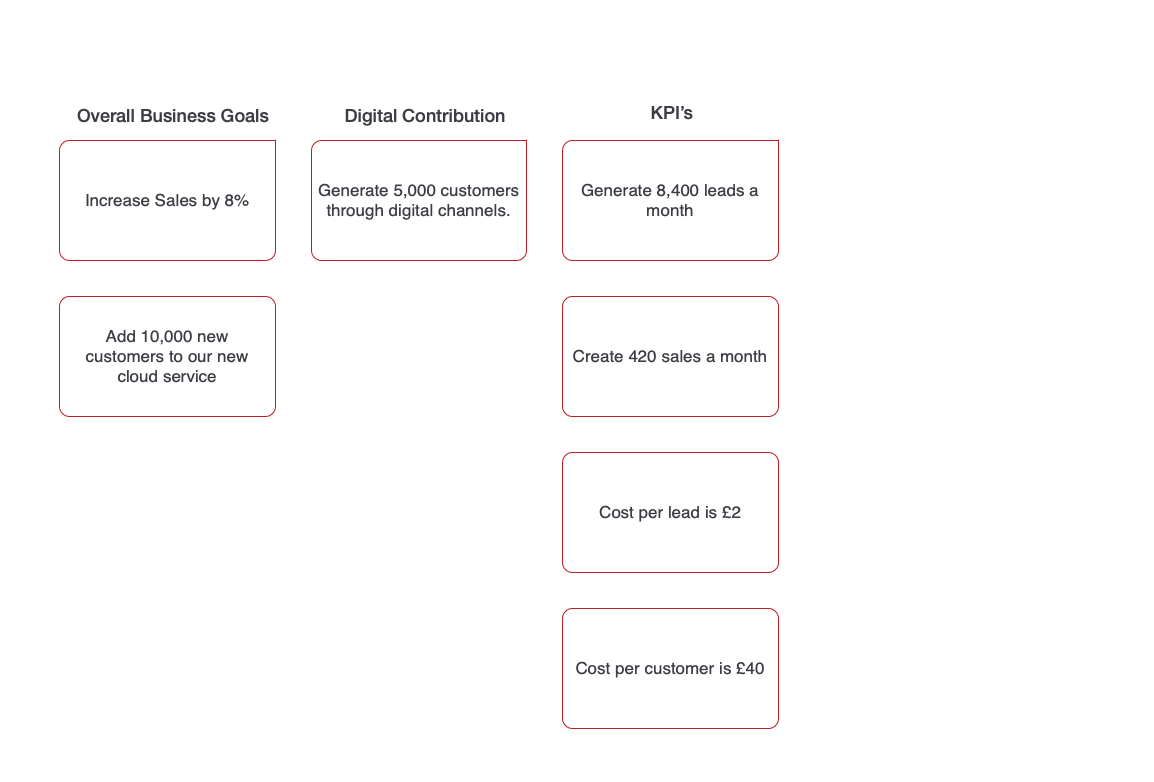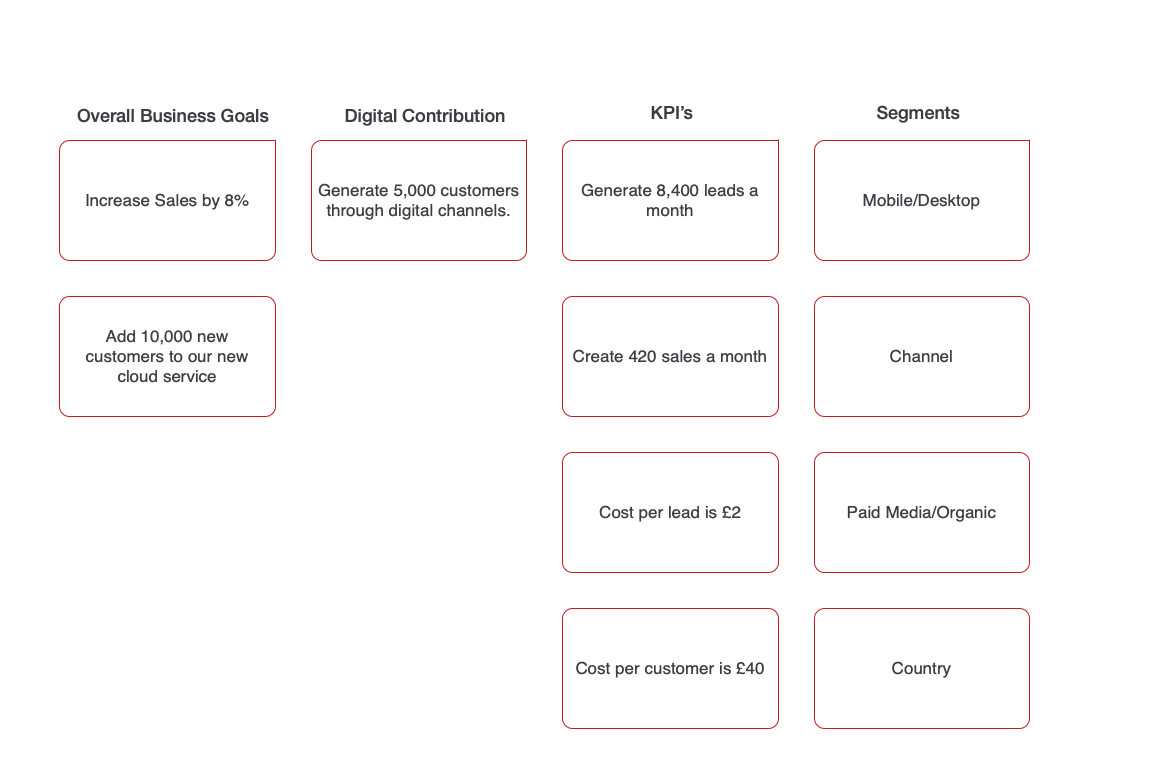In theory, (the two best words when it comes to talking about digital marketing), we can reach millions of people with a comparatively modest budget. It seems incredible, the natural evolution of mass media advertising.
Impressions, likes, click-throughs, comments, retweets. All the numbers, all the time. And they can really impress. The challenge is taking a step back and understanding how those numbers roll up to make a contribution to the overall business.
When going through any annual operating plan, it's easy to understand the top-line goals for a business. For this example, we're going to go top-line too for ease of understanding. So, if the target is to grow 8%, it's usually based around selling more or increasing efficiencies.
The reason we like to define this before we get into any form of digital strategy or campaign planning is that it helps to focus the mind. When the ideas are flying, and the creative juices are flowing, it's useful to ask the question, "Will this help us achieve the goals we've set out?"
We usually run a session with a group of internal stakeholders to get a consensus across a range of disciplines from a business. I'm not going to lie; when we run these sessions, there is a fear in the room that you can almost taste. There is an aversion to committing to a number. It is always easy to get behind a global business number that everyone can get around, but you can rub up against some resistance when that number becomes a tangible goal for your particular department.
We counter this fear with two main points. The first is that this isn't about holding people personably accountable. You shouldn't get fired for not hitting this target. But you do need a focus to make sure that digital activity is seen as a revenue generator rather than an expense. The only way to do that is to understand and demonstrate the digital contribution to the business.
Secondly, it focuses your digital activity on what's essential; outcomes. If a campaign doesn't have a result that is tied to business growth, what's the point? The focus on outcomes subtlety changes the conversations around campaigns. Reporting then all ladders up to the business goals, and there is a healthy discussion about continual improvement. We've worked with clients who reported a fantastic click-through rate from social channels but had a 0.01% conversion rate on the landing page. Activity trumped outcomes. Defining the digital contribution to the business goals helps shift the reporting from vanity metrics to business metrics.
So, how do you start mapping out the digital contribution to the business? It's not rocket science, we take a simple approach to this. It's done in four stages that can be understood at every level within a business, an approach advocated by Avinash Kausik, a digital marketing evangelist at Google and all-round good guy. Let's get stuck in.
Stage 1: Overall Business Goal
Getting your overall business goal should be the easy bit. What's the overarching business objective for the next year? For this exercise, we're going to use metrics that we tend to get handed to us a lot.
For our purposes, using percentages isn't optimal. We're looking for numbers that we can measure against, not percentages. Usually, business goals are presented like this as a generalisation. We're looking to get specific. The deeper understanding you need is how the business plans to achieve this goal. That influences how the digital contribution is defined.
Sometimes you can get that information easily, but we've been involved with businesses that don't get into that detail and share. I know. What we're looking for is something like:
I'm conscious that you can get lost in the weeds here, the devil's in the detail. But this example is to demonstrate the direction for the business. Now that you have an overall number, not a percentage, to work with, the next step is to work out how the digital channels can help hit that goal.
Stage 2: Define Digital Contribution
Depending on your business, the level that digital can influence the business goal can fluctuate. Digital marketing can help this goal in two ways: driving demand and/or raising awareness. These are two separate goals and should be measured separately. We'll look at how we're going to generate demand for the product. All about the £.
For this example, demand relies on generating leads through the website. The business has a number of routes to market, so the digital contribution doesn't need to cover 100% of the leads that the overall business goal lays out.
Through discussions with stakeholders, it's agreed that we are going to set ourselves a target of 5,000 new customers that will convert through digital channels.
Great Happiness! We can now measure the digital contribution to the business:
This is great. We now know what the digital channels need to deliver to help contribute to the business goals. Ideal. You may have a couple of ways to measure digital contributions. Try not to push more than three so that you can keep focus.
Stage 3: KPI's
Who doesn't love themselves a Key Performance Indicator? This is the barometer of success, the way you know that you're on target and what you'll be measuring your tactics against. So, to our example. We know our digital contribution is to generate 5,000 customers. At the moment, we've got a 5% conversion rate on leads to sales. We need to produce 100,000 leads to hit our target. We'd then suggest that you report on a monthly basis, so that means, all things being equal, that you have to generate around 8,400 leads a month.
Is it squeaky bum time yet? Is this a walk in the park? Can the tactics you've used historically achieve this? Do you need to explore new channels? The point is that you're having meaningful discussions with your team and agency partners around the business goals and how to achieve them.
KPI's can also be around costs of leads, cost of sale, time to sales, anything that is useful in determining the performance of your activity to produce outcomes.
Depending on the digital maturity that you're dealing with, focus on the critical KPI's. Don't start chucking everything into the KPI pot. We try to focus on five KPI's at the very, very most. Usually, we hit on four.
Stage 4: Segmentation
Aggregated KPI's are useful at a certain level. But you're going to get into the weeds at some point. We like to outline the segmentation that we're going to apply to the KPI's, again to keep focus. Falling into the rabbit hole of analytics can send you off on crazy directions and take you down pointless paths. Agreeing on the segmentation with all your key stakeholders is important for setting expectations and delivering focused, meaningful reports.
Some segmentation is pretty straightforward; it can be around channels, it can be mobile visits versus desktop, it can be by country. We've even seen segmentation around display sizes. Which is where we ask, "what's the point?". We aim for five key segments to look at, knowing all too well that each segment can drag you into more and more stuff. That stuff can throw up some insight, no doubt, and it's up to your agency partners to find that and present that to you.
But in the first instance, look at segments that can drive actionable insight into the business. Earn your stripes there, then look at adding value.
Bring it all together
You've got four columns;
- Overarching Business Goal
- Digital Contribution
- KPI's
- Segmentation
From here, you can start measuring this against the campaign work ahead (will a certain tactic help deliver on the KPI?), help rein the enthusiastic idea generators within your team back in. We once had someone suggest that they'd like to see a bear pull a caravan across the homepage. Sure, a nice idea but will it really help push the conversion that we're after? Understanding your digital contribution helps to put guard rails on your campaigns to keep focus and prove to the business that digital generates business rather than being an expense.
When the tactics have launched, it starts to help shape conversations around continual improvement. Segmenting the lead KPI's can help find where the best channels are coming from, understanding the cost per lead KPI may help know that the best generator of leads is also the most expensive and perhaps putting more money into another channel that could do with a boost. Lots of conversations, all pulling towards a commonly agreed goal.
The joy doesn't end there. Down the line, reporting becomes more manageable as it starts to follow a structure that everyone has agreed and signed off. It can also be tiered with those higher up the chain getting the overview of the KPI's while those closer to the tactical coalface may get more segmented reports to help improve activity.
Activity without defined outcomes is rife in digital, the shiny, shiny lure of activity is where people head to. But without this crucial stage, you can miss the best opportunity to make sure that you're squeezing every bit of value from your digital activity while proving that you are an income generator for your business. Boom!




